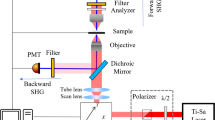Summary
Phase contrast observation on a variety of cell types in culture revealed an extensive phase dark cytoplasmic network consisting of interconnected broad and fine branching trabeculae which extended from the perinuclear region to the cell margin; in structure, size and intracellular distribution, this network closely resembled the endoplasmic reticulum as seen in low power electron micrographs of unsectioned fixed cells of similar type. The networks of living cells were mobile and extraordinarily plastic. Both broad and fine network trabeculae underwent pronounced changes in shape, the broader elements sometimes extending into and partially merging with adjacent fine ones. The fine branching trabeculae altered in length and their junctions With other trabeculae continually shifted about; consequently individual trabeculae moved through the cytoplasmic matrix and the network pattern was forever changing. In some injured cells the networks appeared as highly mobile phase-light canaliculi which periodically opened into pathological vacuoles. The concept of the ER as a membranebo- und vacuolar system serving as an intracellular transport system was discussed in the light of the present findings.
Similar content being viewed by others
References
Buckley, I. K., 1962: Cellular injuryin vitro: phase contrast studies on injured cytoplasm. J. Cell Biol.14, 401–420.
—, 1964: Phase-contrast microscopy of Polyoma-treated rat embryo cells. Proc. Amer. Assoc. Cancer Res.5, 9.
Fawcett, D. W., and S. Ito, 1958: Observations on the cytoplasmic membranes of testicular cells, examined by phase contrast and electron microscopy. J. Biophys. Biochem. Cytol.4, 135–142.
Palade, G. E., 1956: The endoplasmic reticulum. J. Biophys. Biochem. Cytol. 2, Suppl. 85–98.
—, and K. R. Porter, 1954: Studies on the endoplasmic reticulum. I. Its identification in cellsin situ. J. exper. Med.100, 641–656.
Palay, S. L., and S. L. Wissig, 1953: Secretory granules and Nissl substance in fresh supraoptic neurones of the rabbit. Anat. Rec.116, 301–313.
Pappenheimer, J. R., 1953: Passage of molecules through capillary walls. Physiol. Rev.33, 387–423.
Pomerat, C. M., E. M. Todd and D. Goldblatt, 1962: Activity of meningiomal whorlsin vitro. In “The Biology and Treatment of Intracranial Tumors” (W. S. Fields and P. C. Starkey ed.), 1st ed. pp. 104–121. Charles C. Thomas, Springfield, Illinois.
Porter, K. R., 1953: Observations on a submicroscopic basophilic component of cytoplasm. J. exper. Med.97, 727–750.
—, 1954: Electron microscopy of basophilic components of cytoplasm. J. Histochem. Cytochem.2, 346–375.
—, 1956: The sarcoplasmic reticulum in muscle cells of Amblystoma larvac. J. Biophys. Biochem. Cytol.2, Suppl., 165–170.
—, 1961: The ground substance; observations from electron microscopy. In “The Cell” (J. Brächet and A. E. Mirsky ed.), 1st ed. Vol. II, pp. 621–675. Academic Press, New York and London.
- 1964: Personal communication.
—, and F. L. Kallman, 1952: Significance of cell particulates as seen by electron microscopy. Ann. New York Acad. Sci.54, 882–891.
—, A. Claude, and E. F. Fullam, 1945: A study of tissue culture cells by electron microscopy. J. exper. Med.81, 253–246.
Revel, J. P., S. Ito, and D. W. Fawcett, 1958: Electron micrographs of myelin figures of phospholipide simulating intracellular membranes. J. Biophys. Biochem. Cytol.4, 495–498.
Rose, G. G., and C. M. Pomerat, 1960: Phase contrast observations of the endoplasmic reticulum in living tissue cultures. J. Biophys. Biachem. Cytol.8, 425–430.
—, and T. O. Shindler, 1964: The mineralization of emigrating bone cells in tissue culture. Texas Reports on Biology and Medicine22, 174–202.
—, C. M. Pomerat, T. O. Shindler, and J. B. Trunnell, 1958: A cellophane-strip technique for culturing tissue in multipurpose culture chambers. J. Biophys. Biochem. Cytol.4, 761–764.
Thiéry, J. P., 1955: L'ergastoplasme des plasmocytes à l'état vivant. Revue D'Hématologie10, 745–752.
Author information
Authors and Affiliations
Additional information
Aided in part by Grant GB-15 from the National Science Foundation administered by Dr. Donald E. Rounds.
Eleanor Roosevelt Cancer Foundation Fellow — International Union Against Cancer (UICC).
Rights and permissions
About this article
Cite this article
Buckley, I.K. Phase contrast observations on the endoplasmic reticulum of living cells in culture. Protoplasma 59, 569–588 (1965). https://doi.org/10.1007/BF01252457
Received:
Issue Date:
DOI: https://doi.org/10.1007/BF01252457




